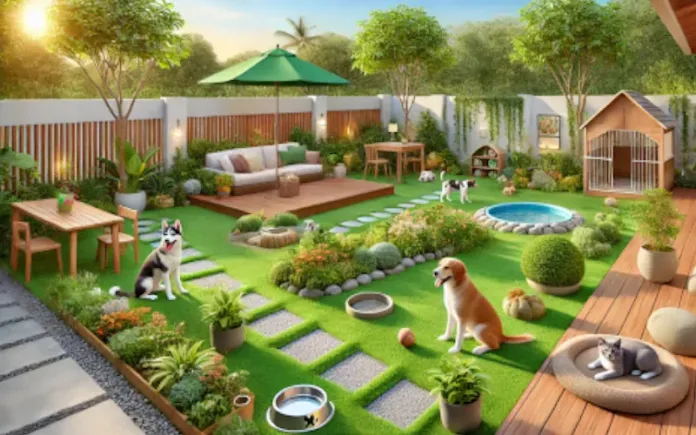Creating a pet-friendly garden is a rewarding endeavor for both you and your furry friends. A well-designed garden can provide a safe, stimulating environment where pets can explore and enjoy nature. This guide will walk you through the necessary steps and tips to design a garden that caters to your pets’ needs while maintaining an appealing landscape.
1. Understand Your Pet’s Needs
Before diving into the design process, it’s crucial to understand the specific needs of your pets. Different animals have different requirements, and catering to these will ensure a harmonious garden. For instance, dogs may need space to run and play, while cats might prefer areas to climb and hide.
2. Choose Pet-Safe Plants
Selecting the right plants is essential in a pet-friendly garden. Numerous typical garden plants can be harmful to pets. Research and choose non-toxic plants that are safe for your animals. Some safe options include:
- Marigolds: Bright and non-toxic, perfect for adding color.
- Roses: Pet-safe and aesthetically pleasing.
- Sunflowers: Non-toxic and fun for pets to interact with.
Avoid plants like lilies, azaleas, and daffodils, which can be harmful to pets if ingested.
3. Create Pet Zones
Designate specific areas within your garden for your pets. This can include:
- Play Areas: Open spaces with durable grass or pet-friendly ground covers where pets can run and play.
- Resting Spots: Shady, quiet areas with comfortable surfaces for your pets to relax.
- Digging Zones: If your dog loves to dig, consider creating a designated digging area filled with sand or loose soil.
4. Ensure Safety
Safety is a paramount concern in a pet-friendly garden. Implement the following measures to keep your pets safe:
- Secure Fencing: Ensure your garden is fully enclosed with secure fencing to prevent pets from wandering off.
- Avoid Toxic Chemicals: Use natural or pet-safe fertilizers and pesticides to avoid accidental poisoning.
- Water Features: If you have a pond or water feature, ensure it’s shallow or has escape routes to prevent accidental drowning.
5. Incorporate Pet-Friendly Landscaping
Design your garden with pet-friendly landscaping in mind. This can include:
- Pathways: Create clear paths with materials that are gentle on paws, such as mulch or smooth stones.
- Shade and Shelter: Incorporate structures like pergolas or doghouses to provide shelter from the elements.
- Interactive Elements: Install features like tunnels, climbing structures, or interactive toys to keep pets engaged.
6. Maintain Regularly
Regular maintenance is key to keeping your pet-friendly garden in top condition. This includes:
- Weed Control: Regularly remove weeds to prevent them from taking over your garden and potentially harming your pets.
- Cleanliness: Keep the garden clean by regularly removing pet waste and fallen leaves.
- Plant Care: Regularly prune and care for your plants to ensure they remain healthy and safe for your pets.
Designing a pet-friendly garden involves thoughtful planning and consideration of your pet’s needs. By choosing safe plants, creating dedicated pet zones, and ensuring a secure environment, you can create a delightful outdoor space for your furry companions. For expert advice and professional assistance, consider consulting with landscape contractors. For more information, don’t hesitate to get in touch. Your pets will thank you for the beautiful and safe garden they can enjoy every day.
